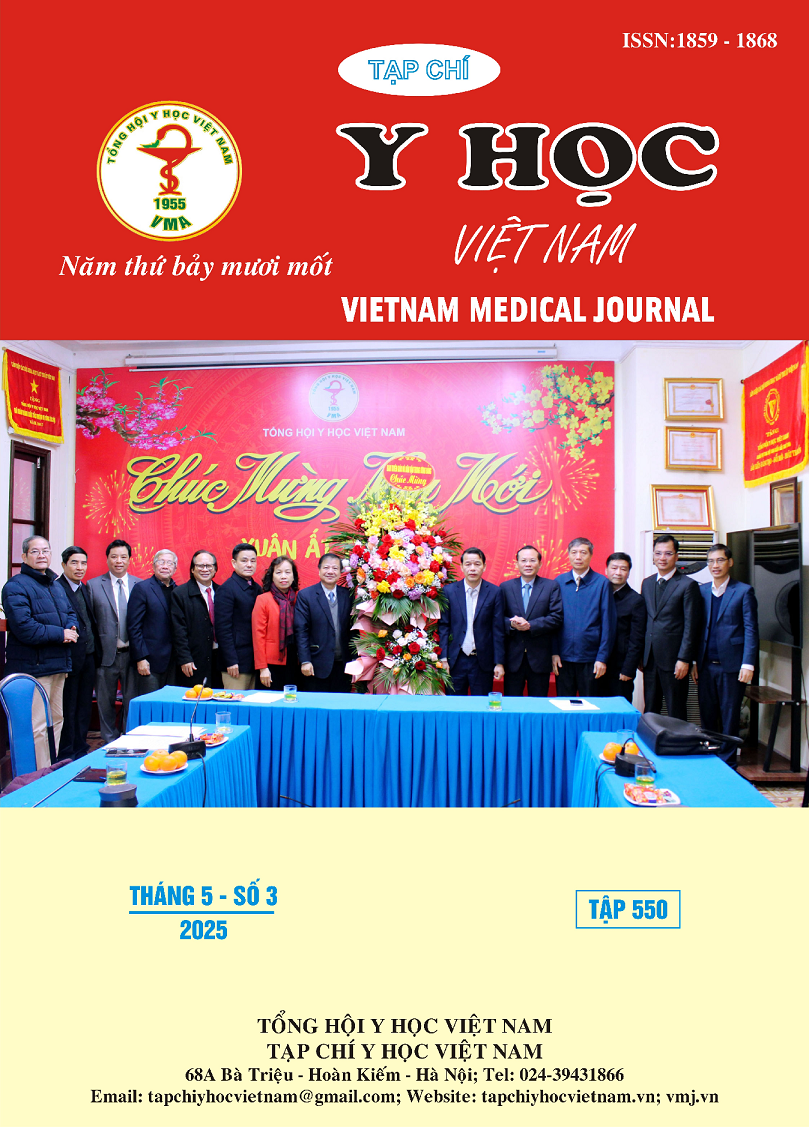THE VALUE OF 18F-FDG PET/CT IN DETECTING RECURRENT BREAST CANCER LESIONS AND ITS RELATIONSHIP WITH CLINICAL AND PARACLINICAL CHARACTERISTICS
Main Article Content
Abstract
Objective: To assess the role of 18F-FDG PET/CT in detecting recurrent breast cancer lesions and its association with certain clinical and paraclinical characteristics. Subjects and Methods: This is a cross-sectional descriptive study conducted on 32 female patients at the National Cancer Hospital, diagnosed with recurrent breast cancer. All patients underwent 18F-FDG PET/CT imaging, and the results were compared with histopathological or cytological findings. Results: The average age of the 32 female patients was 53.7 years (ranging from 39 to 74 years). The most common histopathological type was invasive ductal carcinoma of no special type, accounting for 59.4%. Patients were diagnosed with disease stages prior to recurrence as follows: stage II (43.8%) and stage III (34.4%), with 56.3% having lymph node metastasis. The most frequent sites of recurrence were lymph nodes (53.1%) and the chest wall (18.8%). The median time to detect recurrence was 25 months. 18F-FDG PET/CT accurately diagnosed recurrent disease in 28 cases, yielding a sensitivity of 87.5%, with an average SUVmax of 10.2. Additionally, metastatic lesions in other locations were detected in 15 out of 28 cases. SUVmax values were higher in patients with advanced disease stages, lymph node metastasis, ER-negative, and PR-negative status. No significant difference in SUVmax values was observed across histopathological subgroups. Conclusion: 18F-FDG PET/CT exhibits high sensitivity in detecting recurrent breast cancer lesions. Statistically significant differences in SUVmax values were observed based on lymph node metastasis, disease stage, and ER/PR status.
Article Details
Keywords
recurrent breast cancer, 18F-FDG PET/CT, clinical characteristics, paraclinical characteristics
References
2. Donald C, Matthew G.D, Brian M.M, et al. Breast cancer recurrence: factors impacting occurrence and survival. Ir J Med Sci.2022; 191(6): 2501-2510.
3. Zhang-Yin J. State of the Art in 2022 PET/CT in Breast Cancer: A Review. J Clin Med, 2023; 12(3): 968
4. Yu X, Ling W, Xuehua J, et al. Diagnostic efficacy of 18F-FDG-PET or PET/CT in breast cancer with suspected recurrence: a systematic review and meta-analysis. Nucl Med Commun. 2016; 37(11): 1180-1188.
5. Taalab K, Abutaleb A.S, Moftah S.sG, et al. The diagnostic value of PET/CT in breast cancer recurrence and metastases. Egyptian J. Nucl. 2017;15(2): 37-51.
6. Ying D, Haifeng H, Chunyan W.D.Y, et al. The diagnostic value of 18F-FDG PET/CT in association with serum tumor marker assays in breast cancer recurrence and metastasis. Biomed Res Int. 2015; 2015: 489021.
7. Bawinile H, Lerwine H, Tasmeera E, et al. The Role of PET/CT in Breast Cancer. Diagnostics (Basel).2023;13(4):597.
8. Sinn H.P and Kreipe H. A Brief Overview of the WHO Classification of Breast Tumors, 4th Edition, Focusing on Issues and Updates from the 3rd Edition. Breast Care (Basel). 2013; 8(2):149-154.
9. Armando E.G, Stephen B.E, Gabriel N.H. Eighth Edition of the AJCC Cancer Staging Manual: Breast Cancer. Ann Surg Oncol. 2018; 25(7): 1783-1785.
10. Almir G.V.B.V, Eduardo N.P.L, Rubens C, et al. Correlation between PET/CT results and histological and immunohistochemical findings in breast carcinomas. Radiol Bras. 2014; 47(2):67-73.


